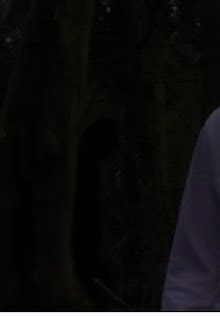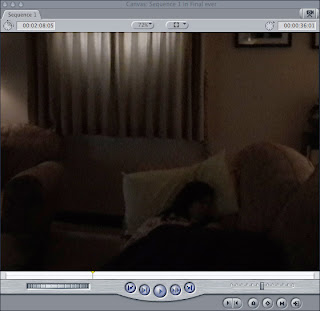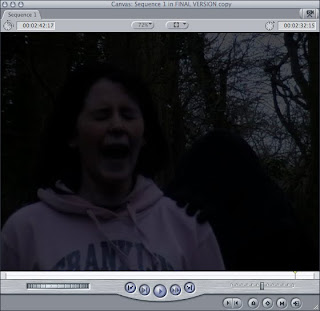I
When we were planning our film, we decided that by using different ideas in our thriller would incorporate generic conventions. We did this by using tense music and a dark setting in the forest. We also thought we would have a ‘stalker’ as an antagonist in our thriller and a girl as the victim. We felt this would work because we have seen it when watching other thrillers. To be able to achieve these conventions we had to edit many parts of the film on final cut express. For example in the forest scene, we felt it was not dark enough outside, so we had to edit the opacity to 26% in order to get the finish we wanted in the background. Another way we achieved darkness in our film was by covering the windows in the house with sheets, because it was still light outside at the time we filmed.
This is one of the windows that we had to cover with a sheet to darken the room.
To keep a tense atmosphere running throughout the opening of our film, we put a base beat with our filming. The way we developed the antagonist in our film was by firstly showing his hand writing, to finally showing his whole body wearing dark clothes.

This is where the just the hand of the antagonist was shown, to eventually the whole body.
The sub-genre of our thriller is action, because there is a lot happening during the thriller where the atmosphere builds and keeps the viewers interested. The main convention that we liked and used was in the film ‘Silence of the Lambs’, where a woman was running through a forest.
Silence of the lambs opening scene
How does your media product represent particular social groups?
In our film, we only have a small number of characters. Our main character is a middle class, white English girl, who is aged 19. She represents a normal everyday girl. Another character in our film was a mysterious character, with a dark personality. During the film, you do not see his face, but you do get to see the dark outline of his body. Our film is not really represented in a stereotypical way, because the main character is an everyday girl.
 |
| From Setting |
What kind of media institution might distribute your media product and why?
I think our film could be produced by a major Hollywood studio, because it is very similar to thriller films that I have watched in the past that have been produced by a Hollyw ood studio. We used similar techniques to a Hollywood film, for example the using of the different types of camera shots. We also used the idea of having a boyfriend and girlfriend, which we agreed was very common in thriller films produced by Hollywood studios. I think the film we made would be a TV movie, because it is quite a creepy film. This would mean it would probably be on a bit later in the evening after the watershed, another reason for this is that the age certificate for the film is a 15, so would not be suitable for people under this age. The film we produced is similar to those made recently, because we used ideas from a variety of films when making ours. In the future, if a large company wanted to use our film, we could make a lot of money by selling merchandise such as posters, t-shirts, figures of the characters and games linked to the film. The ‘mise en scene’ of our thriller involves a dark and gloomy atmosphere, which we made when editing the background and darkening the rooms by placing sheets over the windows.
This is the establishing shot of our thriller.
This is the establishing shot of our thriller.

This shows how we put the sheets over the windows to darken the room.
Who would be the target audience for you media product?
When thinking about the target audience of our thriller, we felt that by making the film suitable for both genders would increase the popularity of the film. It would also be most suitable for teenagers or young adults, who enjoy a tense atmosphere and a thriller. A film that is suitable to ours is ‘Silence of the Lambs’, as the opening scene also takes place in a forest. The film also appeals to a similar audience as ours.
How did you attract/address your audience?
We addressed our thriller to both genders, who are aged 15 and over, we decided to do this as the people who viewed our thriller were of both genders and all aged 15 or over and agreed with the target audience. At the point where ‘Kate’ is captured and screams, both genders may find it scary because there is a tense atmosphere, which could lead to making people jump.

In the scene that takes place in the forest, we used close-ups to show the expressions on the face of ‘Kate’. We also used them on her feet to show her running through the forest. Also we used a mid-shot to be able to show the ‘stalker’ behind ‘Kate’. The audience has to put themselves in the position of ‘Kate’. They will witness ‘Kate’ looking for her boyfriend and eventually being captured. This gives the audience a role to play in the film, as they need to imagine themselves in ‘Kate’s’ position. This also builds up suspense, as the audience starts to imagine what will happen as the film progresses.

In the scene that takes place in the forest, we used close-ups to show the expressions on the face of ‘Kate’. We also used them on her feet to show her running through the forest. Also we used a mid-shot to be able to show the ‘stalker’ behind ‘Kate’. The audience has to put themselves in the position of ‘Kate’. They will witness ‘Kate’ looking for her boyfriend and eventually being captured. This gives the audience a role to play in the film, as they need to imagine themselves in ‘Kate’s’ position. This also builds up suspense, as the audience starts to imagine what will happen as the film progresses.
What have you learnt about technologies from the process of constructing this product?
During the process of constructing the product, we discovered that when we were filming, it was too light. This meant that we had to adjust the opacity when editing, because the camera would not be able to get a clear enough picture if it was too dark outside.

Originally the opacity was 100%.
We then changed it to 26%..
Another problem that we encountered when filming was that the tripod that we were using had broken, meaning that we could not secure the camera on to it properly. This meant we had to secure it with sellotape. When in the forest, it took us quite a long time to find the perfect position for the camera to be. This was because when ‘Kate’ was running in the forest, we needed to pan the camera and when we did the practice run of it; we seemed to have a tree trunk come into view of the camera rather than ‘Kate’. We got used to the camera very quickly and found it relatively easy to use. We found Final Cut Express extremely useful when editing. This was mainly due to the fact that we need a darker background in the forest scene. We learnt on Final Cut Express, that the Opacity of the background can be decreased as well as increased. We also found the transitions available very useful and used the ‘fade’ transition a few times as we felt it linked well into the switching of scenes. We also used the slow motion effect when ‘Kate’ was running through the forest, as we found this very effective. We got used to the camera very quickly and found it relatively easy to use. We also learnt how to fade out the end of the song that we had in the background effectively, so the new one could start without being noticed. We also found Garageband useful, because we were able to change the tempo at which the song was played, so that it was in time with the film.

Originally the opacity was 100%.
We then changed it to 26%..
Another problem that we encountered when filming was that the tripod that we were using had broken, meaning that we could not secure the camera on to it properly. This meant we had to secure it with sellotape. When in the forest, it took us quite a long time to find the perfect position for the camera to be. This was because when ‘Kate’ was running in the forest, we needed to pan the camera and when we did the practice run of it; we seemed to have a tree trunk come into view of the camera rather than ‘Kate’. We got used to the camera very quickly and found it relatively easy to use. We found Final Cut Express extremely useful when editing. This was mainly due to the fact that we need a darker background in the forest scene. We learnt on Final Cut Express, that the Opacity of the background can be decreased as well as increased. We also found the transitions available very useful and used the ‘fade’ transition a few times as we felt it linked well into the switching of scenes. We also used the slow motion effect when ‘Kate’ was running through the forest, as we found this very effective. We got used to the camera very quickly and found it relatively easy to use. We also learnt how to fade out the end of the song that we had in the background effectively, so the new one could start without being noticed. We also found Garageband useful, because we were able to change the tempo at which the song was played, so that it was in time with the film.
This shows how we started to put our thriller together.
Looking back to your preliminary task, what do you feel that you have learnt in the progression from it to the full product?
I think the planning stage was very useful, because it gave us an insight into some of the aspects we needed to include in the planning and making of our film. I also found that after our preliminary task, we were able to find the appropriate camera shot quickly. We found that our planning was very useful, because it meant we could film exactly what we needed at the correct time. We also found it helped our time management, because we pre-determined how long we would film each part for. We had to edit our storyboards during the filming process, because we found that it could be improved by adding to it. An example of something we had to edit in the storyboard would have been when we were supposed to have the camera spinning around ‘Kate’ in the forest, but realised that the camera would have been extremely difficult to keep steady. Instead, ‘Kate’ had to spin round in circles. This worked well in the end, because the camera was kept steady and the same effect that we intended was shown. As the filming progressed, we found that the specific shot types that we used was improved. This was because we began to feel confident whilst using the camera. I think we worked very well as a group, because we all listened to each others ideas and took them into consideration. We also took turns to film different scenes, so everyone had a part in which they filmed. I am very happy with our end product and feel we put in a lot of effort to make the film a success.






0 comments:
Post a Comment